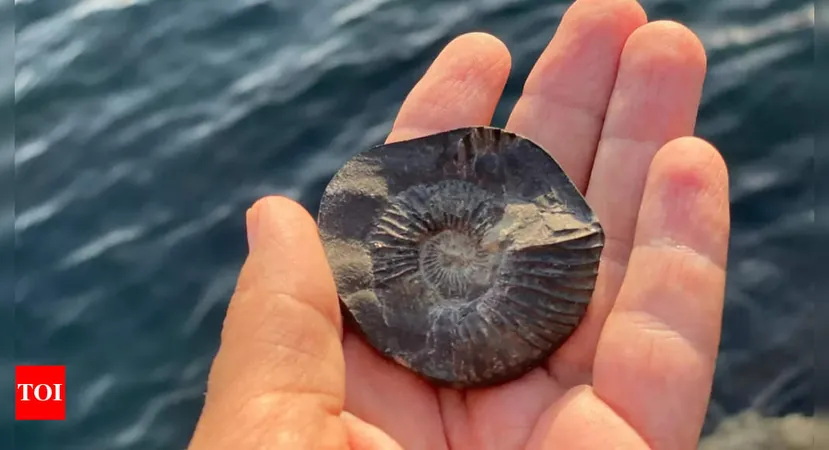
Discovering the Roots of Animal Nervous Systems: A Breakthrough in Evolutionary Biology
2025-01-12
Author: Emma
Overview
In a remarkable revelation, a team of international scientists has pieced together the evolutionary history of the ventral nerve cord in ecdysozoan animals, suggesting that their common ancestor most likely had a single ventral nerve cord. This discovery highlights that the paired nerve cords seen in arthropods, loriciferans, and kinorhynchs have likely evolved independently—enhancing movement coordination among these diverse groups.
Groundbreaking Research
The groundbreaking research, published in Science Advances, sheds new light on the origins of these critical structures during the basal Cambrian period, approximately 500 million years ago. A collaborative team from institutions including Northwest University, Université de Lyon, Queen Mary University of London, and Rey Juan Carlos University meticulously examined fossils sourced from significant Cambrian deposits. Among these were fossils from Scalidophora, a subgroup of the Ecdysozoa.
Understanding Ecdysozoans
Ecdysozoans encompass a wide variety of organisms such as arthropods (insects, crabs), nematodes (roundworms), and lesser-known groups like kinorhynchs (commonly known as "mud dragons") and priapulids (affectionately termed "penis worms"). The complex nervous systems of these animals—comprising both a brain and ventral nerve cords—have puzzled scientists keen to understand the evolutionary relationships between them.
Debate on Ancestral Nerve Cord
For years, researchers have debated whether the ancestral ecdysozoan originally possessed a single or paired nerve cord. Although kinorhynchs and loriciferans exhibit nervous system designs that resemble those of arthropods, their distant phylogenetic connections raise questions: Are these similarities due to convergent evolution, or do they hint at a shared evolutionary ancestry?
Pivotal Study of Scalidophorans
The study of Scalidophorans, emerging during the crucial early Cambrian period, turns out to be pivotal in understanding the evolution of the ventral nerve cord in ecdysozoans. The researchers conducted their studies on fossils unearthed from various formations—including the Fortunian Kuanchuanpu Formation, the Chengjiang Biota, and the Wuliuan period—discovering long structures positioned on the ventral side of these ancient organisms.
Significant Findings
Dr. Deng Wang and Dr. Jean Vannier, part of the research team, stated, "These structures closely resemble the ventral nerve cords seen in modern priapulids." Additionally, the analysis revealed distinct impressions of single ventral nerve cords within the fossils, providing insights into the likely ancestral condition of scalidophorans.
Phylogenetic Analysis
Phylogenetic analysis confirms that the common ancestor of all ecdysozoans is indeed characterized by a single ventral nerve cord, while the paired nerve cords observed in arthropods, kinorhynchs, and loriciferans likely represent independently evolved traits. Dr. Chema Martin-Durán remarked, "This leads us to propose that the common ancestor of all ecdysozoans possessed a single ventral nerve cord. The paired nerve cords observed in later groups likely resulted from evolutionary adaptations."
Enhanced Movement Coordination
Furthermore, the emergence of these paired nerve cords has contributed to enhanced movement coordination, particularly in segmented animals. Dr. María Herranz added, "During the Precambrian-Cambrian transition, evolutionary changes in the nervous and muscular systems are believed to have been connected to the development of appendages, enabling more complex modes of locomotion."
Significance of the Study
These revelations enhance our understanding of evolutionary biology and provide crucial context about how early neural structures set the groundwork for the diverse and complex nervous systems seen in modern animals. This study marks a significant leap in unraveling the intricacies of animal evolution—a topic that continues to captivate scientists and biologists alike.
Future Research Directions
Stay tuned as researchers continue to uncover the mysteries of our planet’s ancient life forms and their evolutionary paths!









 Brasil (PT)
Brasil (PT)
 Canada (EN)
Canada (EN)
 Chile (ES)
Chile (ES)
 Česko (CS)
Česko (CS)
 대한민국 (KO)
대한민국 (KO)
 España (ES)
España (ES)
 France (FR)
France (FR)
 Hong Kong (EN)
Hong Kong (EN)
 Italia (IT)
Italia (IT)
 日本 (JA)
日本 (JA)
 Magyarország (HU)
Magyarország (HU)
 Norge (NO)
Norge (NO)
 Polska (PL)
Polska (PL)
 Schweiz (DE)
Schweiz (DE)
 Singapore (EN)
Singapore (EN)
 Sverige (SV)
Sverige (SV)
 Suomi (FI)
Suomi (FI)
 Türkiye (TR)
Türkiye (TR)
 الإمارات العربية المتحدة (AR)
الإمارات العربية المتحدة (AR)